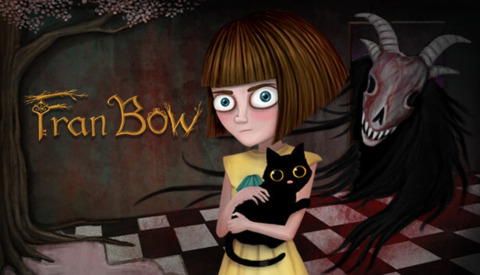Indie Game of the Week 293: Fran Bow
By Mento 1 Comments

Last week we covered Stranga's Red Bow, and this week we're covering Fran Bow from Swedish team Killmonday Games. That's right, b-words: Welcome to Octo-Bow! Ocbowter? Bowtober? At any rate, while both games share a number of similarities—adventure games with horror vibes, polite pre-teen female protagonists, general thematic weirdness—I would say the atmosphere is several degrees more perturbing in this one. Fran Bow sees its eponymous heroine be witness to the death of her parents by a shadowy figure resembling a demon, and decides to find her cat and her aunt and return to some semblance of her former life. Of course, reality chooses not to make it easy for her, first by dumping her in a crooked insane asylum and then later into some truly bizarre predicaments.
As a traditional point-and-click adventure game, Fran Bow is comparatively straightforward as far as its mechanics are concerned. You find items, combine them with others occasionally, and activate hotspots with them to make progress in the current mission. NPCs can give you some idea of what to do and where to go, either directly or indirectly, and Fran has a couple of responses where the second usually exists to cut a conversation short though might also be the same request spoken in an alternative tone of voice that could lead to better results. One major difference with Fran Bow is the option to pop one of her "Duotine" pills: a bottle of red capsules that, once swallowed, allows her to see and explore a different reality. This nightmare reality is only one notch less disturbing than that of Saya no Uta (maybe don't Google that) and presents what may be hiding just behind the veil of logic and rationality that protects the normal human world: the game starts exploring its own take on inter-dimensional travel in later chapters, suggesting Fran isn't just on a bad trip whenever she takes one of her pills.

An example of these two dimensions competing with each other to become objective reality can be found almost immediately upon starting the game, as Fran emancipates the red pills from a nurse station after distracting its owner with a broken curtain. All of Fran's fellow child patients suffer various psychoses, but it's only after visiting the other reality that you understand their plights are much worse than it appears on the surface. While over there, though, you can continue interacting with hotspots and can even find new items to use in the original world: there's an implication that the objects exist in both but only became accessible in the nightmare dimension, due to a missing guard or a now-broken barrier. Another puzzle involves returning a key to a rack close to where a nurse can see you, but by switching to the nightmare dimension first where the nurse is missing (or dead) and depositing the key in the equivalent rack there you can evade her notice. What begins as a suggestion that you're just seeing something you were never meant to see is followed by the revelation that you are travelling between realities rather than merely observing them, and the game continues to make interesting use of this mechanic throughout.
While I've yet to see the full game through, there's a certain rug-pulling quality to its narrative flow that I'm loath to expatiate too much since those twists are core to its appeal. What begins as a somewhat edgy American McGee-esque take on Alice in Wonderland—or perhaps the introduction to Return to Oz, where Dorothy undergoes electro-shock therapy to help with her delusions of talking scarecrows and tin men—begins to take on a more anthology structure as she escapes the mental asylum in the first chapter and thwarts a conjoined pair of witches in the second. The third, which I'm currently in the progress of completing, appears to throw away the whole Halloween blueprint entirely while still adhering to its own internal sense of lore and logic. While the game's mechanics don't change—barring a few simple action mini-games which can be skipped if they're not to your liking—thematically it's a little more chaotic as a whole, and I'd dare say more intriguing than early impressions suggested.

Since the game is glomming onto Alice in Wonderland to some extent, the heroine's speech patterns tend to err towards the polite, innocently naïve, and incongruously positive like a well-heeled Victorian schoolgirl even in spite of the horrors that surround her. Most (but certainly not all) NPCs respond in kind, even the villains, which can add to the overall surreal atmosphere of the game. Given it's a game from a non-English-speaking country you can expect to see some unusual turns of phrases and typos scattered throughout, but on the whole the writing is fairly decent and does a fine job continuing to ratchet up the strangeness as the game goes through its phases while never wavering in its 19th-century storybook approach. The visual style has a similarly storybook simplicity also, but at the same time doesn't skimp on the ample amounts of gore and violence, so heed the content warnings for those. The music stings are expertly applied to underline the game's eerier moments and occasional dramatic jumpscares. Ultimately, while there are some fun horror moments for fans of the macabre, the game's narrative strengths lie more in its unpredictable trajectory and hints at a deeper lore at work as Fran bounces from one mishap to the next. I'm curious to see where it heads off to next.
Rating: 4 out of 5. (So far.)
| < Back to 292: Red Bow | The First 100 | The Second 100 | > Forward to 294: Greak: Memories of Azur |
